
The Sleeping Scholar (1997), έργο του αμερικανού ζωγράφου F. Scott Hess. Εντάσσεται στη σειρά έργων Οι 'Ωρες της Ημέρας που εμπνεύστηκε από το μεσαιωνικό Βιβλίο των Ωρών.
"The Sleeping Scholar is 2 PM in my Hours of the Day series. After finishing his lunch the scholar sleeps as neighborhood delinquents spread the pages of his manuscript across the parched grass of a suburban park. Flowing water gurgles the soundtrack to his dreams out of a black pipe that empties into a mercuric pond floating a burning toy sailboat. The younger of the boys is disturbed by the smoke, but the elder reveals a face devoid of any emotion except malice." Βλ. Open Museum.

"The Cleansing is 1 a.m. in my Hours of the Day series. Though most think the image is of a nude angel, it is not. The figures are derived from a corner of the Villa of Mysteries in Pompeii, and thus predate Christianity. The figures in the painting for the 1 p.m. afternoon Hour in this series are also derived from a wall in the same room. The background has a view of a cityscape at night, a motif that continues through all the dream hours. Nearer is a house, a chopped down tree, and a chasm into which a fence is falling." Βλ. Open Museum.
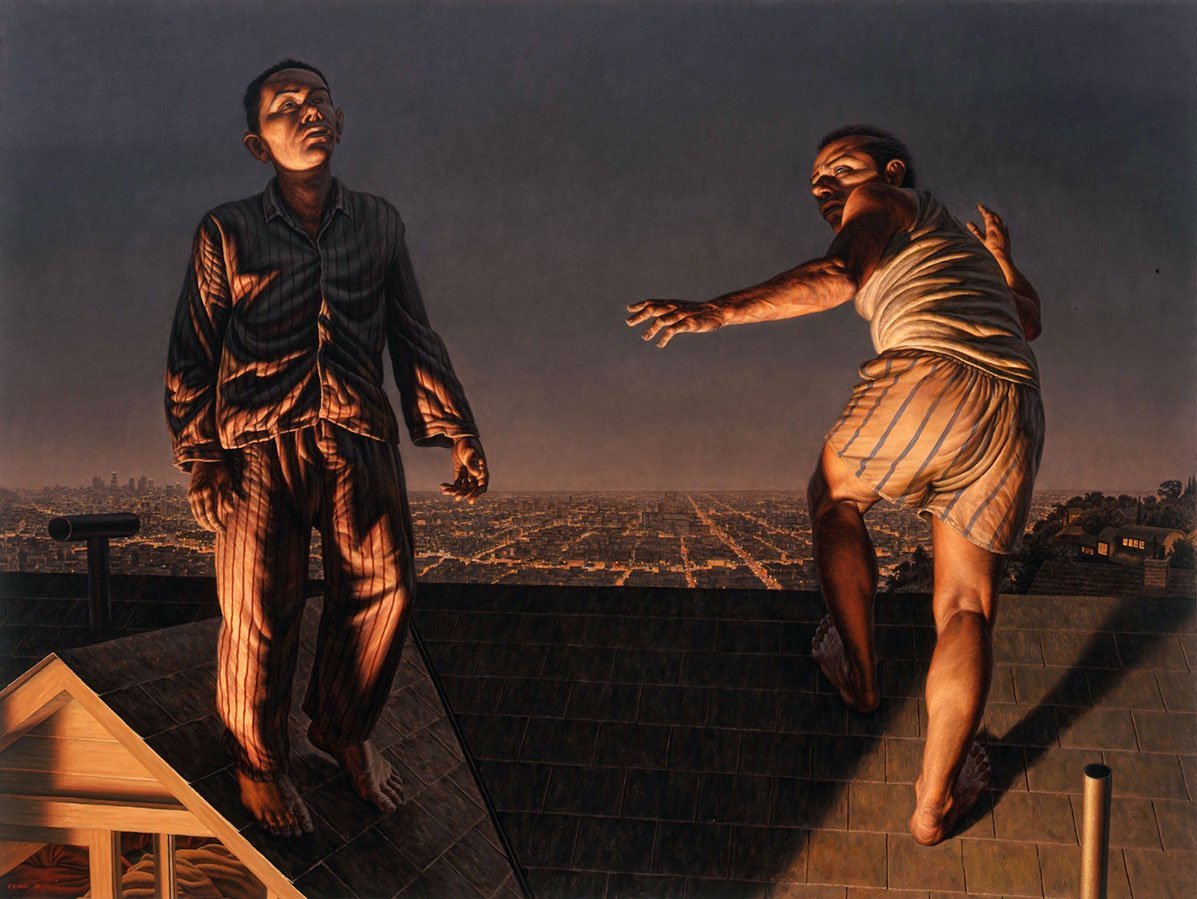
"On the Roof is 2 a.m. in my Hours of the Day series, and it is one of my favorite paintings from my entire career. I think that is because I succeeded in stripping it down to bare basics, from a starting point that was quite gaudy. It was also my first major attempt at using a classical 17th century Dutch painting technique, and that delivered a subtlety that was missing in so much of my earlier work. The painting depicts a father and teenage son on the roof of their home in the middle of the night. The father reaches out, worried, while the son gazes at the heavens in a lost reverie." Βλ. Open Museum.

"Fire is 3 a.m. in my Hours of the Day series. When shown at the Orange County Museum of Art, it was perhaps the most popular of the cycle, with drama, beauty, and that stab of swimming pool blue countering the hot flames. Posed by my eldest daughter, the little girl stares up at the destruction of her home with a look of awe. Silhouetted against the turquoise of the neighbor's pool is her hand, tentatively reaching forward. Across from it, the shriveled remnants of a rose shy away from the heat." Βλ. Open Museum.
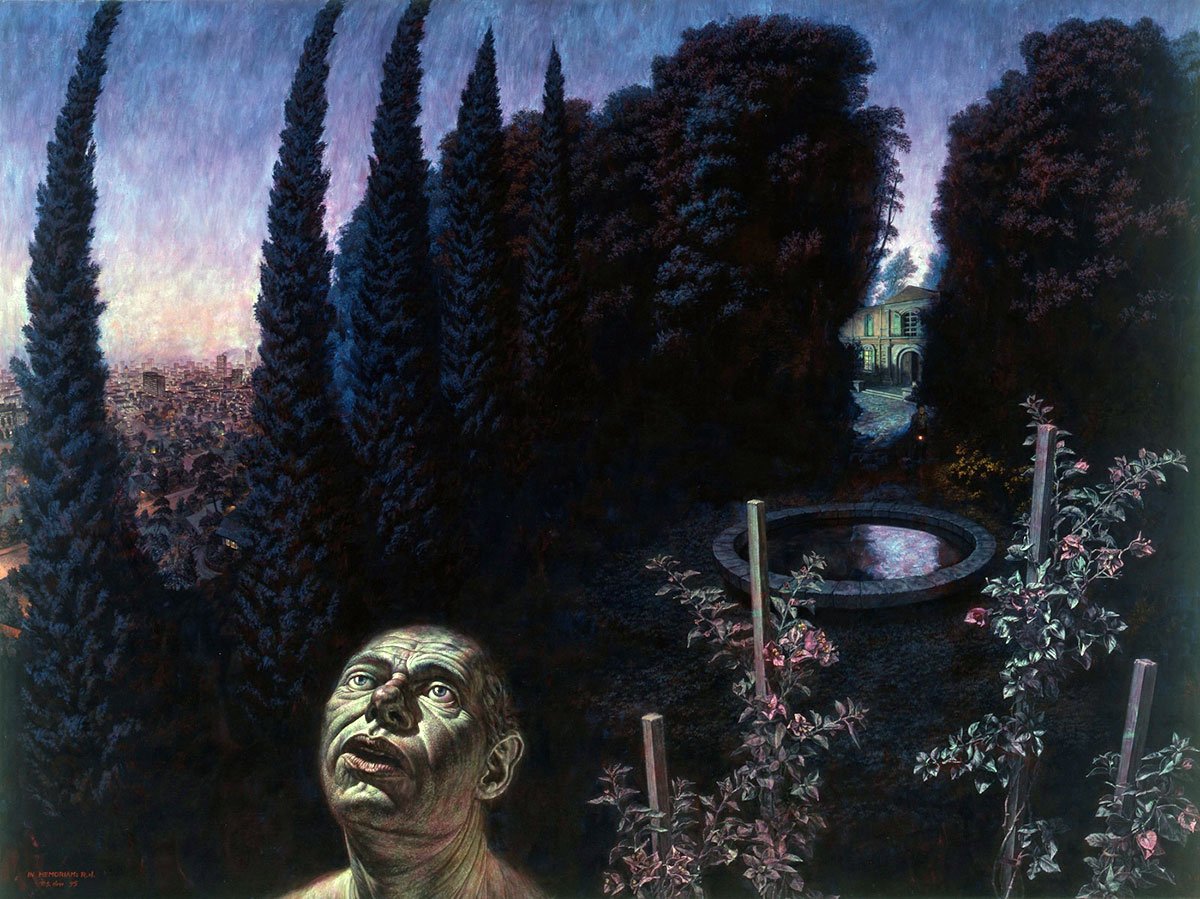
"4 a.m. in my Hours of the Day series, The Night Gardner's Escape is one of the earliest pieces of the cycle. Poised on a hill above the city, the old man of the Hours stares heavenward. Behind him we see a villa through a cleft in the trees, and a dark figure with a flashlight. Near him several young bougainvillea plants bloom in noxious colors. The strange tinting of the piece is due to some technical problems with the base pigments I used to build a little texture. The painting is dedicated to my former professor in Vienna, Rudolf Hausner, who died several months before I began the painting." Βλ. Open Museum.

"Staged at five in the morning, Floodplain is easily the most controversial painting in my Hours of the Day series. It depicts a woman alone in the pre-dawn light, giving birth in the mud. Her face is wrenched in pain as she bites down on a scrap of cloth to silence her screams. Illuminated by the beam of a flashlight, she grips the neck of her infant in a desperate effort to expel him from her body. It is a straight-forward image of a thoroughly human experience, yet one that is rarely ever depicted in Western Art." Βλ. Open Museum.

"6 a.m. in the Hours of the Day series, The Lotus Flower depicts a boy, a middle-aged man, and an old man in a boat. A crone in a bathrobe and tennis shoes hands them her catch of the day. Behind her the large flower of a Lotus plant blossoms as the morning sun struggles to break through the mist. Painted in the egg tempera and oil Mixed Technique, the colors are soft and muted, but the old lady is one of the more memorable characters in the whole epic." Βλ. Open Museum.
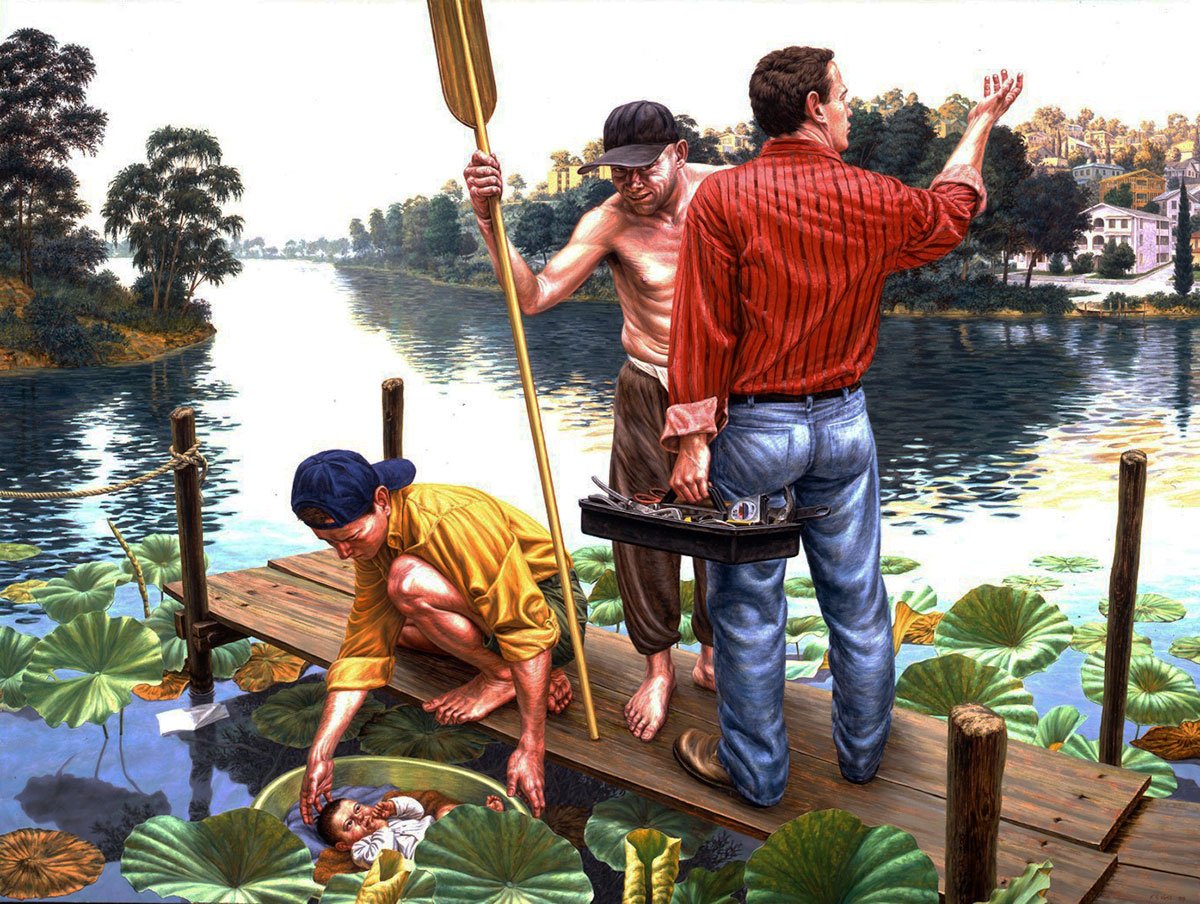
"The Contract is 7 a.m. in the Hours of the Day series. Three men on a dock, perhaps those from The Lotus Flower an hour earlier, are in the process of discovering an infant floating on the river in a plastic tub. Near them, a piece of paper sinks beneath the pier. Could it be a note explaining the babe's origin, or the cause of its predicament? Or is it the contract of the painting's title?" Βλ. Open Museum.
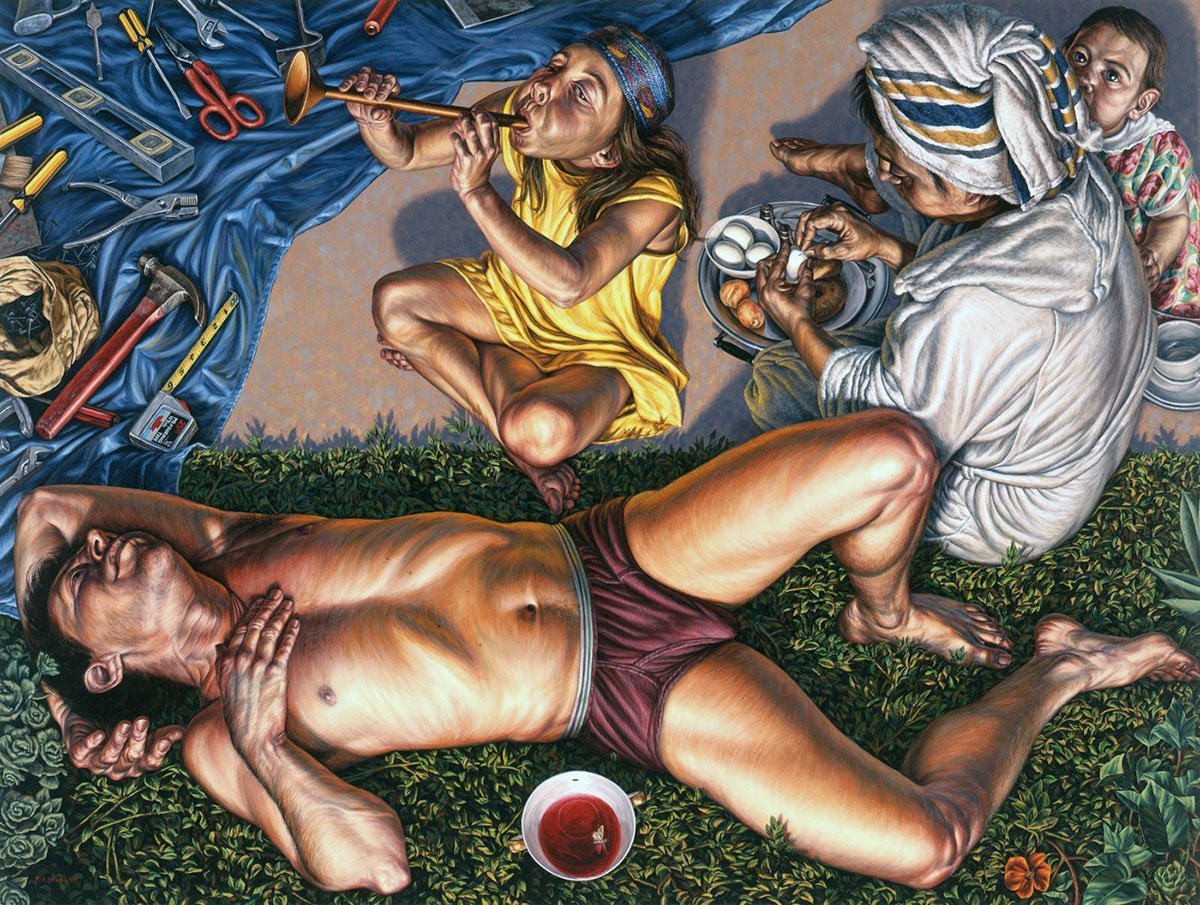
"8 a.m. in my Hours of the Day series, Noah Forgotten depicts a family in the early morning light. The father awakes blearily from a hard night of dreaming, the tools he'll need for his day of work are already at hand. His wife prepares a breakfast, while one daughter announces the morning with a blast of a horn. A portrait of the F. Scott Hess family in 1995, Noah Forgotten is arguably the least popular of all twenty-four images in the Hours series. Why the artist, stretched out in only his maroon underwear, failed to elicit much public admiration remains a mystery." Βλ. Open Museum.

"9 a.m. in the Hours of the Day series, The Architect is a self-portrait of the artist and the last piece to be painted in the cycle. It is derived from Vermeer's The Geographer, but substitutes the tools of the architect's trade for that of the scientist. The morning hours in the series are a time of work, and this worker appears to have stayed-up all night and is putting the finishing touches on a model of a commissioned house. The tiny figures he is gluing in are from the background of the 10 a.m. hour. Βλ. Open Museum.

"Renovation is 10 a.m. in the Hours of the Day series. A group of men are intently reconstructing a house on a sunny morning, while children play in the background. The setting is similar to the view from my backyard in the Echo Park neighborhood of Los Angeles, and the building they were banging away on was my little shack/studio that I worked out of for many years. I'd thrown up some 2 × 4′s on it's porch just for this image, and had to tear them down afterwards as the demands of my pictorial composition were at odds with proper building techniques for my little studio extension." Βλ. Open Museum.
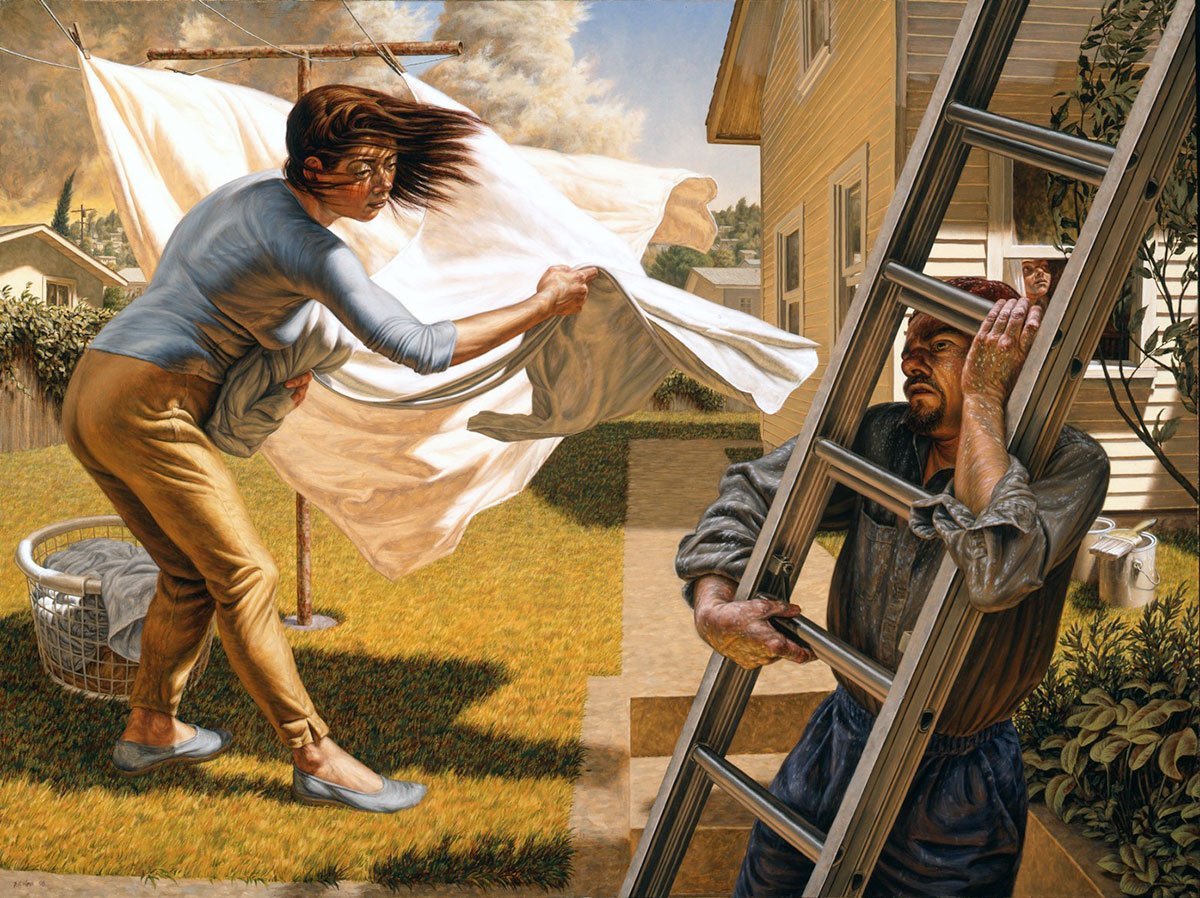
"White Wash is 11 a.m. in the Hours of the Day series. The morning of work is coming to a close. The house that was planned and built, is now in the midst of being painted, white-washed. The woman is quickly pulling in the laundry (also the white wash), while a tempest is brewing beyond the distant hills. Either a thunder storm that will drench the parched ground, or a fire storm that will destroy all in its path, it hints at the dangers of another possible cover up: the white washing of issues in a relationship and the potential consequences thereof." Βλ. Open Museum.

"L'Orange Sauvage is noon in my Hours of the Day series. The idea for the title came from something my father-in-law said. His French was better than his English. We had an orange tree next to the house with very bitter oranges, and the first time he tasted them he translated from the French; "These are savage oranges!" He meant 'wild', but I liked the phrase.
The image shows a family watching a child perform. Based on the pierrot figures from Watteau, this little clown is standing on a paint-splattered box in front of a hung canvas or sheet. The oranges that were being juggled are on the ground, but the performance drags on, and the audience sweats in the hot sun." Βλ. Open Museum.
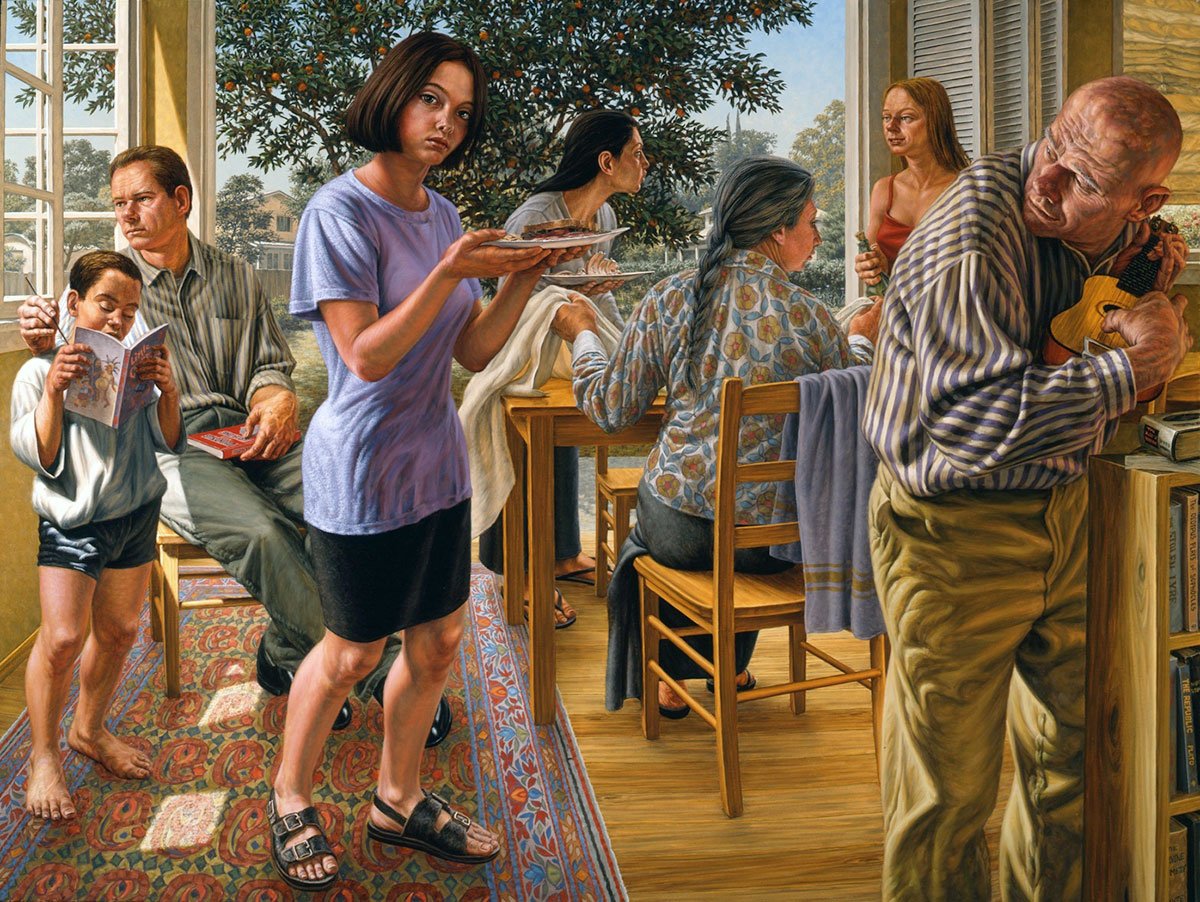
"Initiation is 1 PM in my Hours of the Day series. Set after lunch, it features most of the characters of the mythical family of the Hours. A distracted father teaches his son to read; a girl carries a plate of food that will appear in the next hour; the women clearing the table gossip excitedly; and the old man strums a wicked tune on a child's guitar. Like its pendant piece, The Cleansing (1 AM), the inspiration for these figures grace an entire wall at the Villa of Mysteries in Pompeii." Βλ. Open Museum.
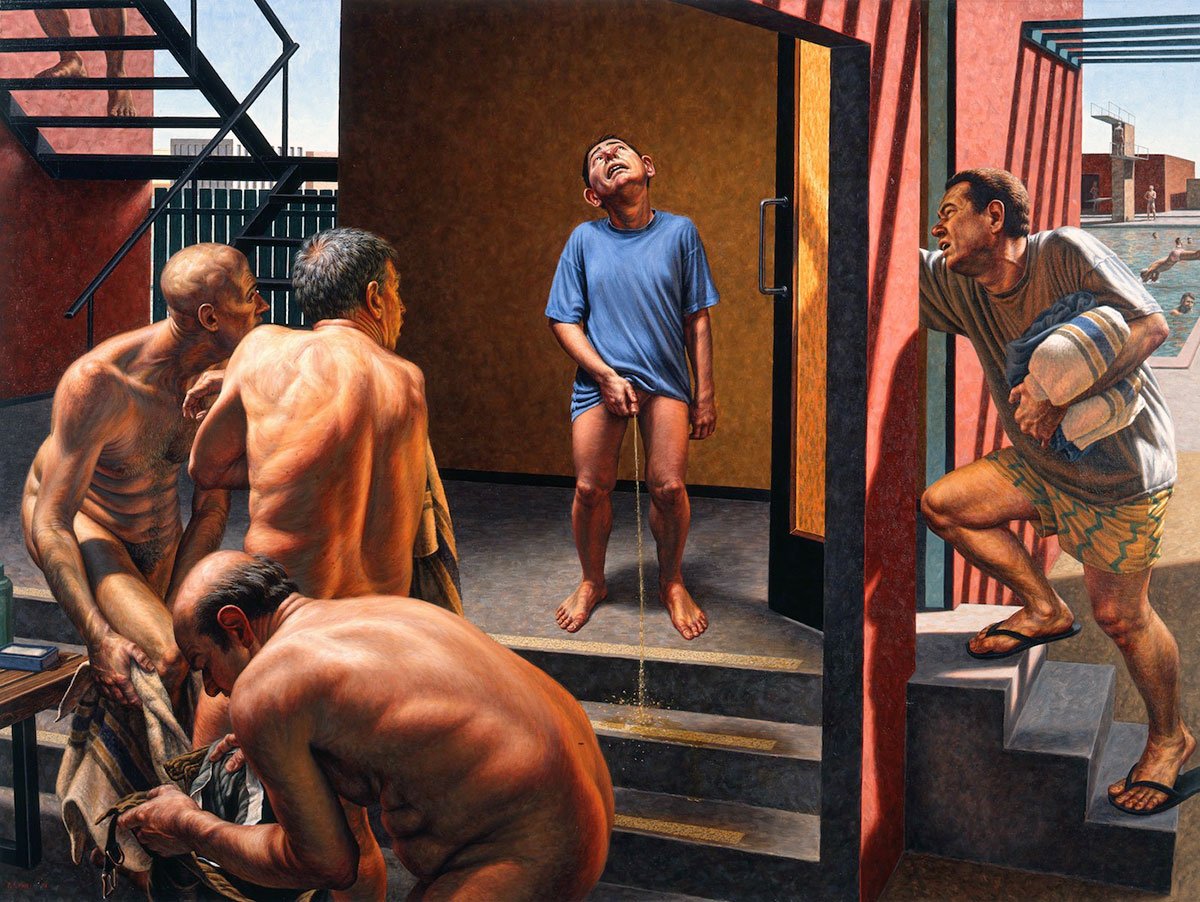
"Τhe Pissing Boy represents 3 PM in my Hours of the Day series. Six months after I completed it in 1998, I suddenly grasped what it was about, and how it intersects with my earliest art making. My parents divorced when I was seven years old, and after age eleven I didn't see or hear from my father for 32 years. I began to make erotic drawings shortly after he left, and continued this through my college years. In my twenties I realized that my images of bound women were an attempt to restrain the archetypal woman (my mother), to prevent a further abandonment. This painting also made me understand that the erotic work, and to some extent my work as a whole, was meant to shock the establishment, the 'paternal' authority that I both desired attention from and simultaneously distrusted. The boy pisses into the room where the older men gawk in disbelief, while his father enters, too late." Βλ. Open Museum.
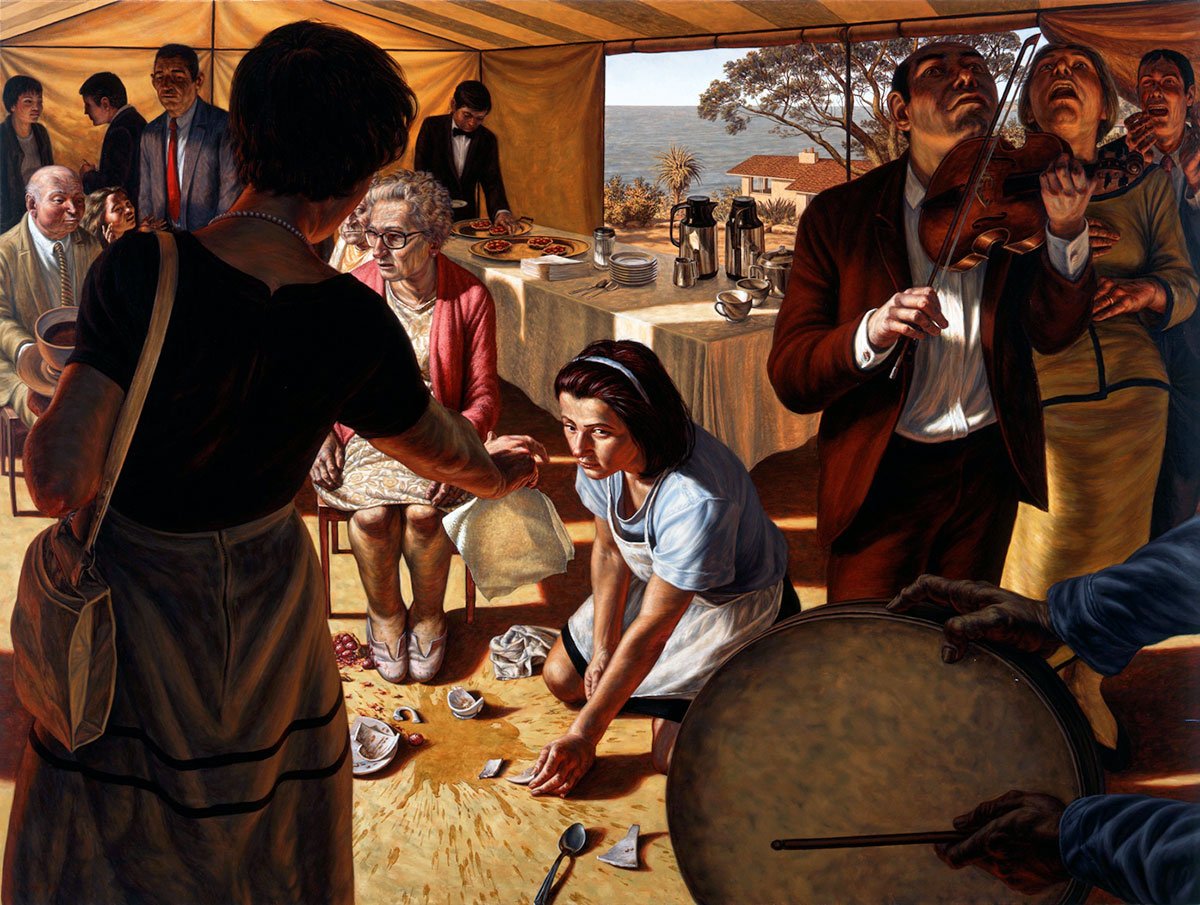
"Performance is 4 p.m. in The Hours of the Day. The stream of liquids that begins in the 2 p.m. hour and reaches its apotheosis with the Pissing Boy, here comes to a crashing end with an old woman's dropped teacup. In the violin player, the uncontrolled performance of the boy from 3 p.m. has evolved into an artistic expression of some merit. Whatever the event taking place under the big tent is, the music holds the attention of most, even in the midst of a minor disturbance." Βλ. Open Museum.
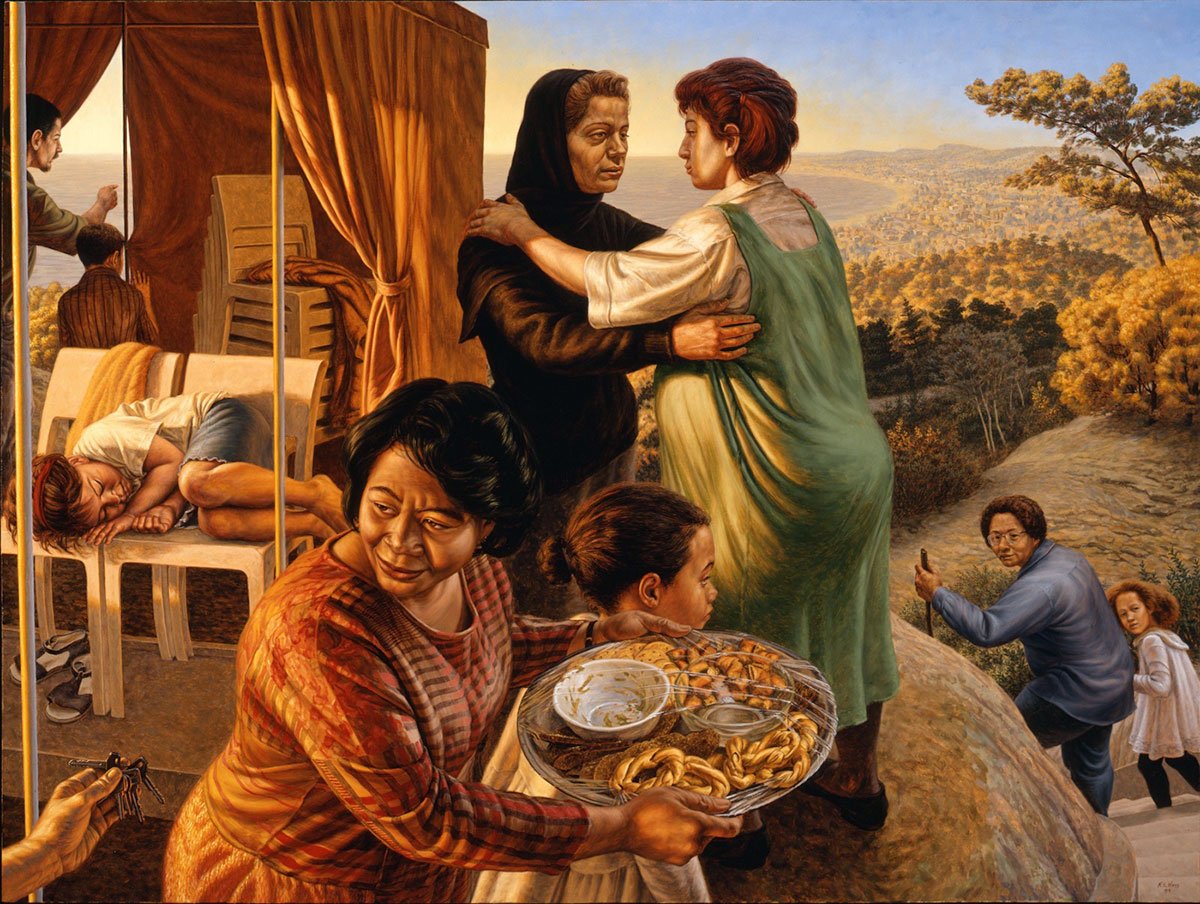
"Mothers on the Mount is 5 p.m. in my Hours of the Day. It was inspired by the women who ran the co-op preschool my daughters attended. The general meetings were excruciating for me, and probably for most of the other males present. The women were clearly in charge, but these gatherings allowed each to speak ad infinitum, no matter how off topic. I had the feeling men would have finished the business at hand much more efficiently and then run home to watch football. There seemed to be a different mode of operation here. The women were strengthening their interconnections, respecting each members opinion and building the network that was the real glue of the co-op. Ultimately, the children benefited greatly from this structured, communal embrace, and in this painting I wished to acknowledge the wisdom of this maternal method. The central mother with the tray is our friend Valerie (a real power at the preschool), who posed for me along with her two daughters. She turns her head to communicate with the person whose hand comes in lower left, holding a set of keys." Βλ. Open Museum.

"The Reception is the 6 p.m. hour in my Hours of the Day series. The old man character is a cook, bringing a fish platter up from the kitchen, where a gaggle of women converse. His profession stems from the only employment I ever had outside of art... short order cook. That was back in the 70s, so I envision him as an extrapolation of an alternate self. He hands the tray to a waitress, who I imagined as the same woman who bears a child at 5 a.m., and is in Open Window at 8p.m., and Stolen Feast at 9 p.m. A musician waits for his gig to begin, and behind him suited men eat, drink, and discuss the business at hand." Βλ. Open Museum.

"Through the Fence is 7 p.m. in my Hours of the Day series. Elements from each hour connect the previous image to this one, and other elements connect to the 8 p.m. hour. The suited men from the Reception are engaged here, their action suspect but undefined. The fish on a tray has morphed into a prone woman, whose position continues into the next hour, as does the bamboo growing outside the fence. The evening hours are taken over by lust and sex, expressed through the characters of the Hours extended family. A barrier is being crossed, though its exact meaning remains obscure." Βλ. Open Museum.
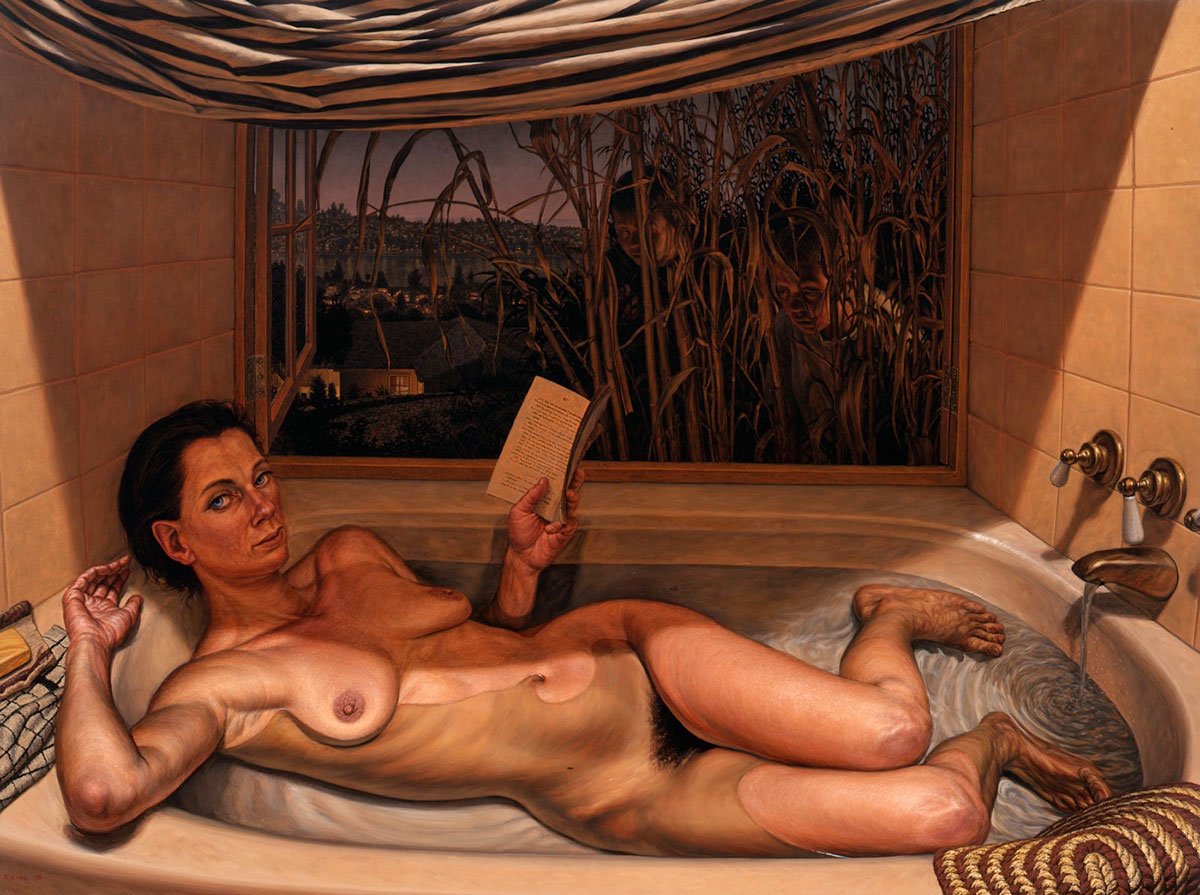
"The Open Window is 8 p.m. in my Hours of the Day series. A woman relaxes in her bath, reading a book (Oedipus Rex). Outside, two little boys rustle through the bamboo, mesmerized by the scene before them. Is she aware she is being watched? Posed by the same woman who appears in the 5 a.m. birth painting, one of the boys is the very same child who was emerging from her in that image. Perhaps it is another Sophoclean tragedy in the making." Βλ. Open Museum.

"The Stolen Feast is 9 p.m. in my Hours of the Day series. The evening hours morph from the socializing paintings of the afternoon and dinner hour, to images of sex and its multiple implications. The prone woman of 7 and 8 p.m. is now on the bed, enjoying a feast of lobster and shrimp. The old cook sips a Pinot Grigio, looking over his shoulder smugly. The woman holds a shrimp between her fingers, and stares at her lover with something less than adoration. Is it his child she bears in the 5 a.m. hour? Out the window a full moon rises above the little city, and warm light streams from apartment windows and storefronts." Βλ. Open Museum.
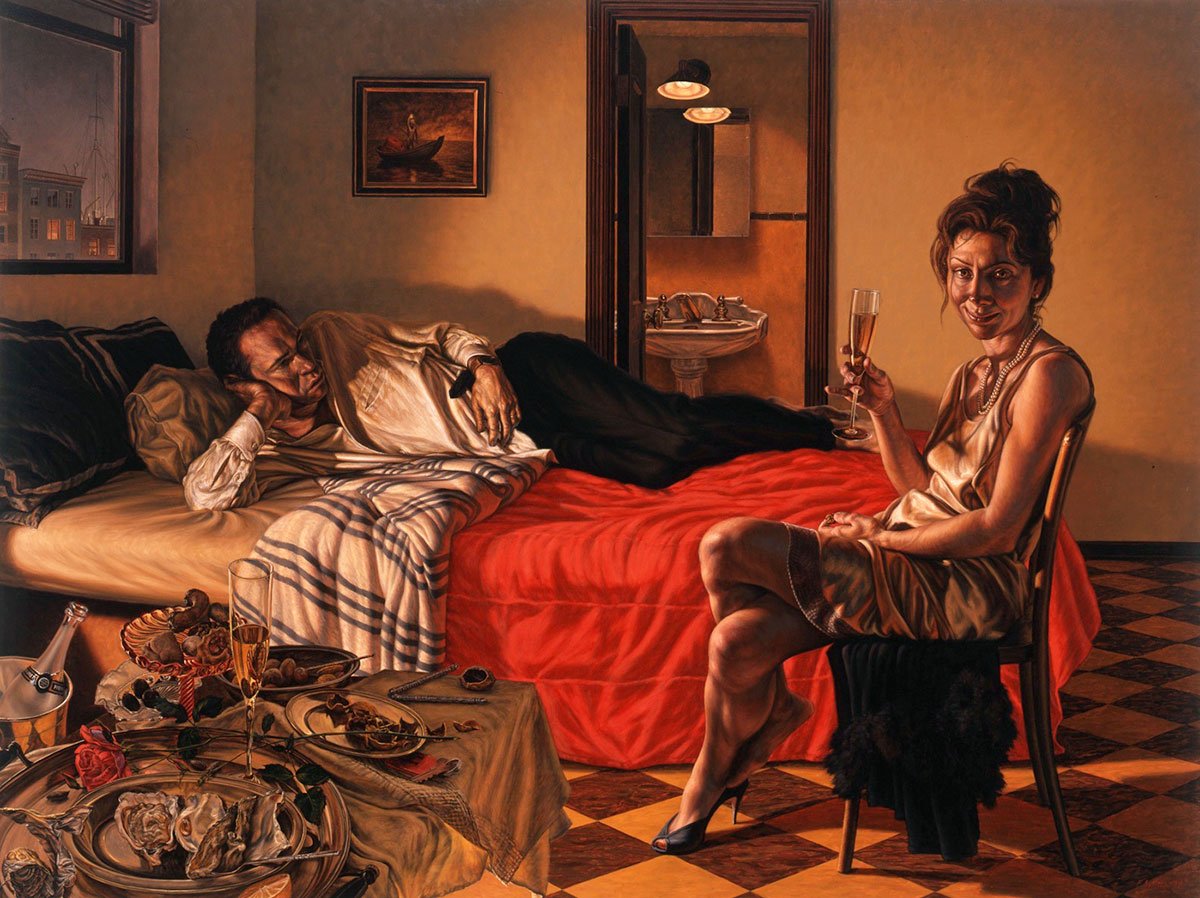
"10 p.m. in my Hours of the Day series, Champagne depicts a couple in a hotel room in an unidentified port city. The red blanket, emblem of the eroticism of the evening hours, dominates the center of the composition. The atmosphere is melancholy, a post-coital reverie. The abandoned remains of an hor dourves and dessert tray litter a table to the lower left, while the woman raises her champagne glass for one more sip." Βλ. Open Museum.
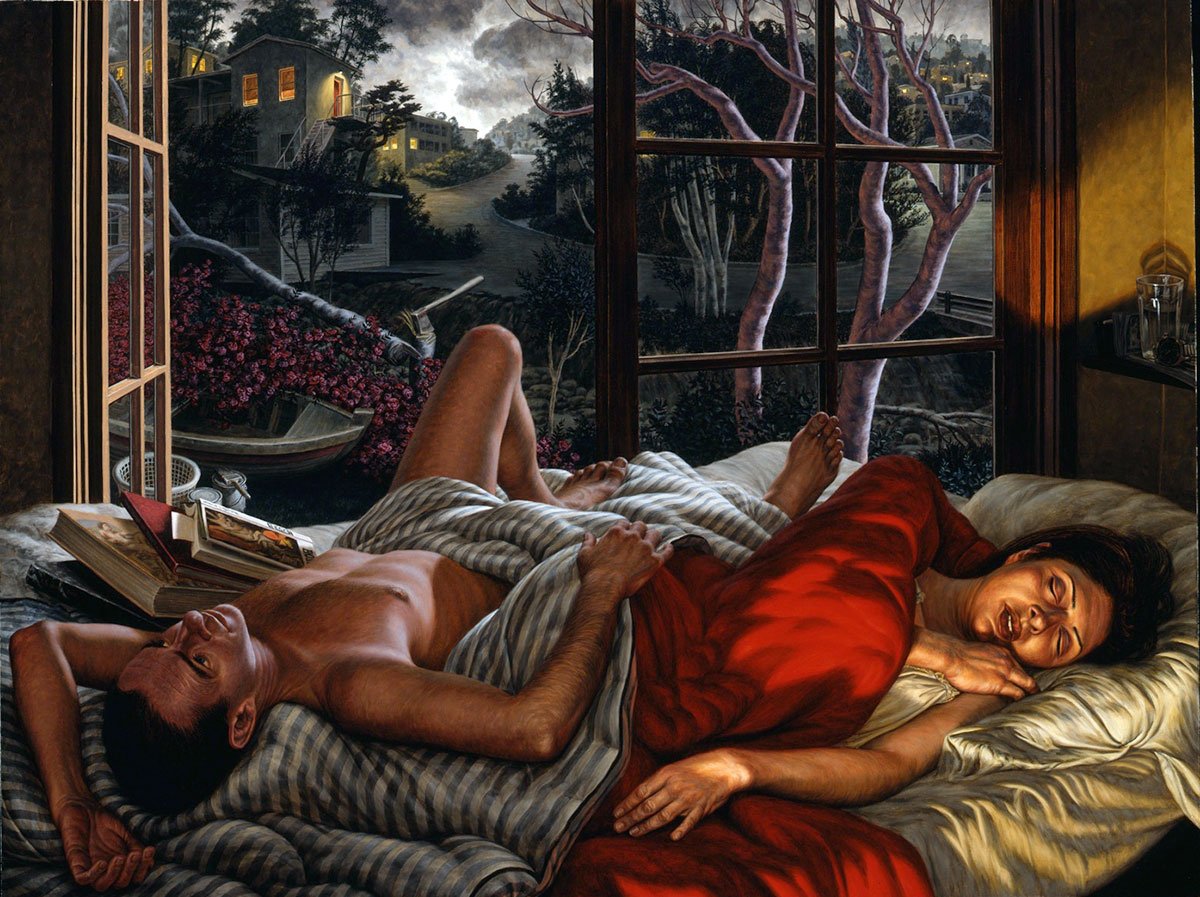
"The Sleep of Trees. 11 p.m. in my Hours of the Day series. The woman sleeps, but the man is twisted in the sheets, restless. Sketchbooks, and tomes on Michelangelo and Bosch are at his side. The rigid, gridded interior gives way to a mounting storm outside. The laundry basket and paint brushes from the 11 a.m. hour sit in the grass, while the boat from Through the Fence (7 p.m.) is swamped by roses. The trees swirl and twist, past the house with the red door, up the road, to the electrified storm clouds in the distance." Βλ. Open Museum.
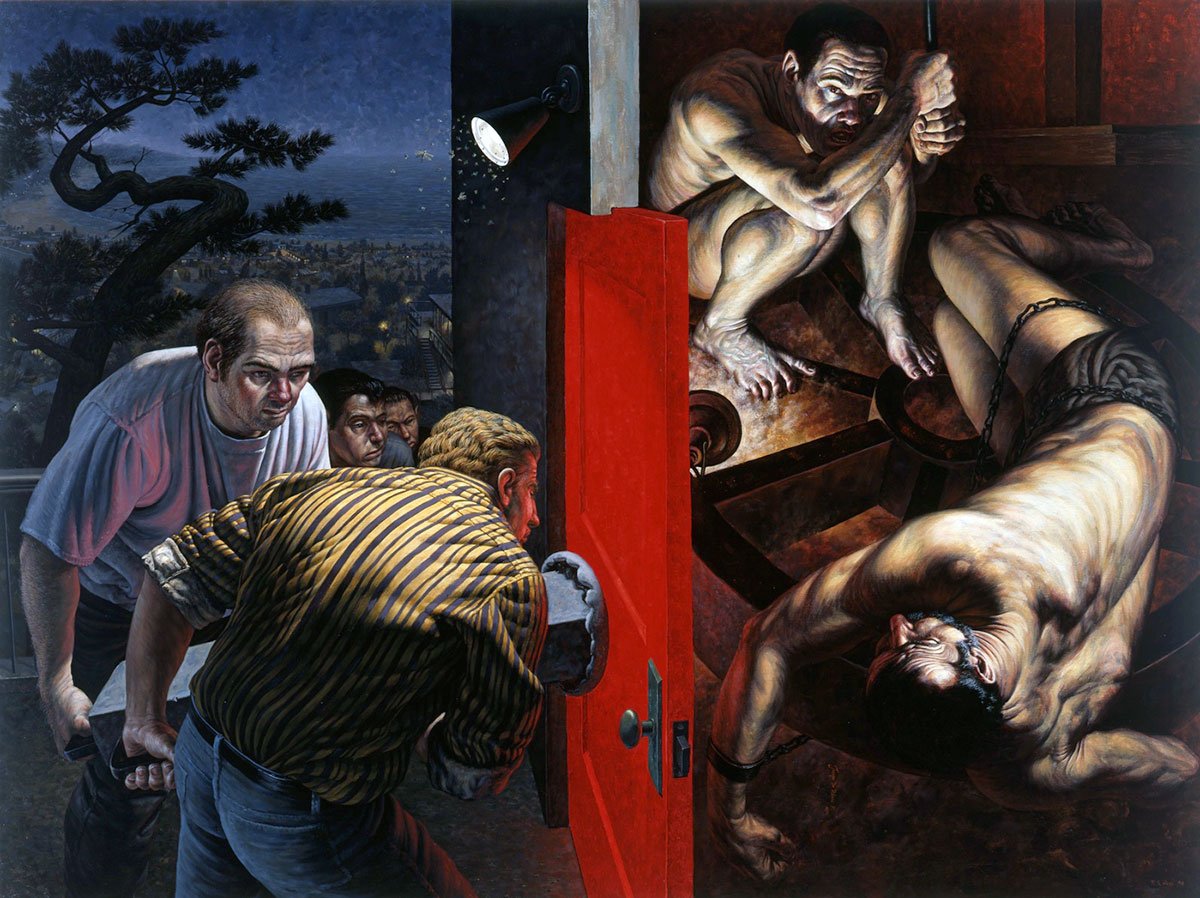
"The Red Door, midnight in my Hours of the Day, was the first painting created for the series. It represented a new direction for me, a break from the social-political works that I'd created all through the 1980s. I felt those works were limited by their attachment to easily defined issues of American society. In talks I could nail down their content in a few sentences, and thus kill the work. The artist's word is the definitive statement. In the Red Door, the image rules. The meaning is left open-ended. The viewer is led down a narrative path, and then abandoned at the fork(s) in the road. There are multiple interpretations, and several layers of content, and I felt the interplay of these made for a much richer and more profoundly personal work." Βλ. Open Museum.










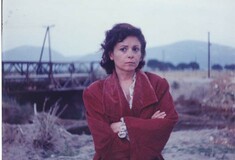




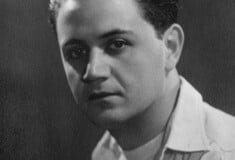




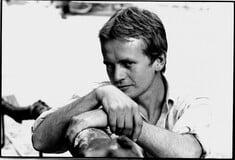




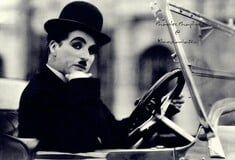
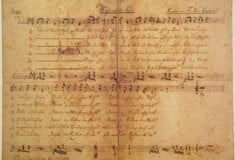


σχόλια